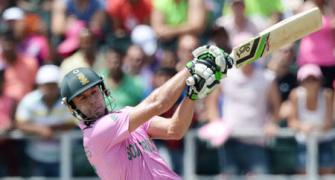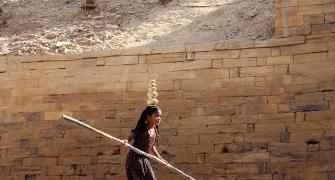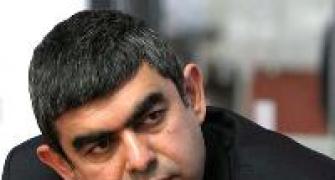Eight states and Union Territories have Muslim share of population in excess of national average of 13 per cent. Mayank Mishra reports

The argument given by supporters of the ghar wapsi (homecoming) campaign is that unless corrective measures are taken up urgently, there is a danger to the existing demographic profile of the country. Many leaders of the Sangh parivar this reporter spoke to say that the way the population of some religious groups is growing; there is a possibility of Hindus being reduced to a religious minority in several states.
An article in the January 4 issue of the Rashtriya Swayamsevak Sangh's mouthpiece, Organiser, has offered some statistics in support of this argument. It says, "There was a 5.2 per cent decadal (1991-2001) growth in Hindu population of Manipur. However, at the same time, Christians grew by 36.6 per cent and Muslims by 43.1 per cent." It further adds, "North-eastern states, excluding Assam, recorded 50.6 per cent growth in Christians and 42.4 per cent growth in Muslims (in the same period)."
Justifying the ghar wapsi campaign, a senior RSS functionary told this reporter; "Just check the growth rate of the population of Muslims and Christians since 1947. You will then realise why we will soon have five more states and union territories -- Kerala, Manipur, Goa, Daman and Arunachal Pradesh -- where Hindus will be reduced to a minority. How can we let that happen?"
A few aberrations in certain pockets aside, does the long term trend support this thesis? Data reviewed by Business Standard suggest otherwise. It is true there are variations in growth rates among communities, with some growing at a rate marginally higher than others. But there is a distinct declining trend visible in case of all communities.
In the decade of 1991-2001, for which data is available, while the average annual growth of Hindus fell by 23 basis points (from 2.05 to 1.82 per cent) from the previous decade, the decline was much sharper of 27 basis points (from 2.85 to 2.58 per cent) in the case of Muslims. Incidentally, the fear of alteration in the demographic structure of the country resurfaced following publication of the 2001 census data on religion in 2004.
Dr Mohan Rao, professor at Jawaharlal Nehru University, says what is ignored in all such discussion is that "the rate of decline is very significant" in the case of Muslims. Author of many research papers on the subject, the professor argues, "the politics of hate" using a certain kind of demography is not unique to India and such discourse "feeds into Islamophobia globally." He adds that as early as in 1909, U N Mukherji wrote a book titled Hindus: A Dying Race which was "deeply riddled with inaccuracies, and wild flights of prediction of the future."
Data suggest even the long-term trend is one of decline in growth rates of all communities. In the period from 1961 to 2001, while the population of Hindus grew at an average annual rate of 2.04 per cent, that of Muslims and Christians increased by 2.70 per cent and 2.02 per cent, respectively. What is noticeable in the same period is the decline in growth rates of all religious communities, some more and some less depending on the phase of demographic transition they are in.
Even with regard to specific states, the review of data in the context they are in dispels concerns raised in some quarters. In Manipur, for instance, as per the census 2001 data, the population of Hindus grew at 5.9 per cent between 1991-2001 while that of Muslims and Christians grew at 43 per cent and 17.69 per cent respectively. Census operations were not carried out in three sub-divisions of the state in 2001.
What is more, according to the detailed analysis available at the Manipur government website, in the said decade, the proportion of Christians in the total population of the state fell from 34.11 per cent to 34.04. It is true that in the same period, the share of Hindus in the total population of the state dropped by a whopping 11 percentage points. But that was partly because the share of the 'other' religious category rose from 0.77 per cent in 1991 to 10.85 per cent in 2001. According to the state government website, the category of 'other' consists of those who are distinct from the followers of Hinduism, Islam, Christianity, Sikhism, Buddhism or Jainism.
In other north-eastern states, the rate of growth of Muslims and Christians has been much faster than of Hindus. But in most cases, that can be attributed to a low base effect. In Arunachal Pradesh, for instance, after a growth of 73.41 per cent from 1991 to 2001, the number of Muslims stood at 20,675. In Mizoram, the population of Muslims grew by a whopping 122.54 per cent in the same period. But in terms of absolute number, there were 10,099 Muslims during the period when census operation was carried in the state in 2001.
Demographers also point out significant regional variation in rates of growth of population for all communities. In an essay in the Economic and Political Weekly (January 29, 2005), P M Kulkarni and Manoj Aagarajan wrote: "While discussing religious differentials in India, one must also note that fertility for a religion varies substantially across states. Fertility among Hindus of Uttar Pradesh is higher than that of Hindus of Tamil Nadu and the same holds true for Muslims. This suggests there is no 'Hindu fertility' or 'Muslim fertility' or 'Christian fertility' as such. Besides, even in individual states, there is heterogeneity within a religion."
In the whole of south India, for instance, the average annual population growth rate of Muslims at 1.66 per cent between 1991-2001 was way below the national average of 1.9 per cent in the same period. The average annual population growth rate of Muslims in Kerala and Tamil Nadu were even lower.
A completely different set of factors, illegal influx of Bangladeshi migrants being the most prominent one, could be behind the rise in proportions of Muslims in West Bengal and some north-eastern states. The country has witnessed a constant inflow of people from Bangladesh since 1971. In 1971, Muslims constituted 20.46 per cent of West Bengal's population. It reached 25.37 per cent in 2001. Similarly in Assam, the share of Muslims rose from 24.56 per cent to 30.92 per cent during the period.
Large share, low growth:
- Eight states and UTs have Muslim share of population in excess of national average of 13 per cent
- Five of them registered population growth less than the national average for Muslims between 1991-2001
- Two recorded growth rate of Muslim population less than the overall national rate
- Spurt in growth rate of Muslim population seen in states where they are in significant minority (less than 13 per cent)
Source: EPW report
Also read: Gharvapasi: Home is Where the Heart is!











